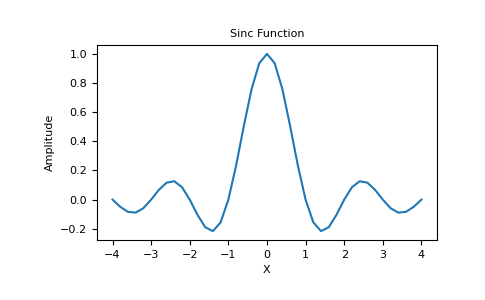numpy.sinc¶
-
numpy.sinc(x)[source]¶ Return the normalized sinc function.
The sinc function is
.
Note
Note the normalization factor of
piused in the definition. This is the most commonly used definition in signal processing. Usesinc(x / np.pi)to obtain the unnormalized sinc functionthat is more common in mathematics.
- Parameters
- x
ndarray Array (possibly multi-dimensional) of values for which to to calculate
sinc(x).
- x
- Returns
- out
ndarray sinc(x), which has the same shape as the input.
- out
Notes
sinc(0)is the limit value 1.The name sinc is short for “sine cardinal” or “sinus cardinalis”.
The sinc function is used in various signal processing applications, including in anti-aliasing, in the construction of a Lanczos resampling filter, and in interpolation.
For bandlimited interpolation of discrete-time signals, the ideal interpolation kernel is proportional to the sinc function.
References
- 1
Weisstein, Eric W. “Sinc Function.” From MathWorld–A Wolfram Web Resource. http://mathworld.wolfram.com/SincFunction.html
- 2
Wikipedia, “Sinc function”, https://en.wikipedia.org/wiki/Sinc_function
Examples
>>> import matplotlib.pyplot as plt >>> x = np.linspace(-4, 4, 41) >>> np.sinc(x) array([-3.89804309e-17, -4.92362781e-02, -8.40918587e-02, # may vary -8.90384387e-02, -5.84680802e-02, 3.89804309e-17, 6.68206631e-02, 1.16434881e-01, 1.26137788e-01, 8.50444803e-02, -3.89804309e-17, -1.03943254e-01, -1.89206682e-01, -2.16236208e-01, -1.55914881e-01, 3.89804309e-17, 2.33872321e-01, 5.04551152e-01, 7.56826729e-01, 9.35489284e-01, 1.00000000e+00, 9.35489284e-01, 7.56826729e-01, 5.04551152e-01, 2.33872321e-01, 3.89804309e-17, -1.55914881e-01, -2.16236208e-01, -1.89206682e-01, -1.03943254e-01, -3.89804309e-17, 8.50444803e-02, 1.26137788e-01, 1.16434881e-01, 6.68206631e-02, 3.89804309e-17, -5.84680802e-02, -8.90384387e-02, -8.40918587e-02, -4.92362781e-02, -3.89804309e-17])
>>> plt.plot(x, np.sinc(x)) [<matplotlib.lines.Line2D object at 0x...>] >>> plt.title("Sinc Function") Text(0.5, 1.0, 'Sinc Function') >>> plt.ylabel("Amplitude") Text(0, 0.5, 'Amplitude') >>> plt.xlabel("X") Text(0.5, 0, 'X') >>> plt.show()
